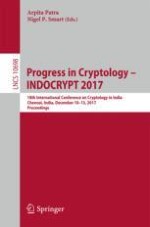2017 | OriginalPaper | Buchkapitel
CCA-secure Predicate Encryption from Pair Encoding in Prime Order Groups: Generic and Efficient
verfasst von : Sanjit Chatterjee, Sayantan Mukherjee, Tapas Pandit
Erschienen in: Progress in Cryptology – INDOCRYPT 2017
Aktivieren Sie unsere intelligente Suche, um passende Fachinhalte oder Patente zu finden.
Wählen Sie Textabschnitte aus um mit Künstlicher Intelligenz passenden Patente zu finden. powered by
Markieren Sie Textabschnitte, um KI-gestützt weitere passende Inhalte zu finden. powered by


